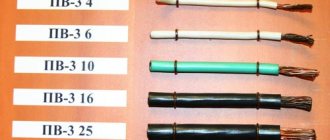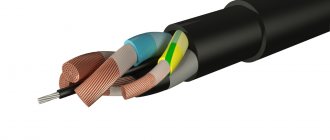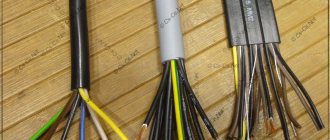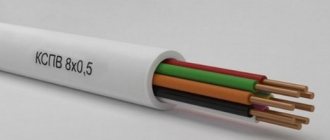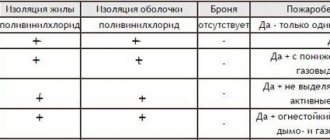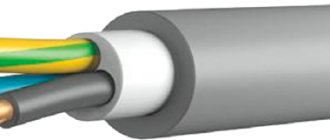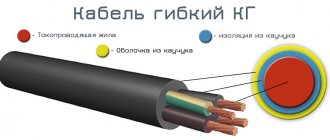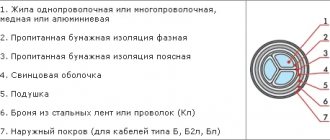KGN power cable is a highly specialized cable product. As the specification states, it is intended for connecting mobile electrical installations to industrial electrical networks - for example, mounted on certain self-propelled mechanisms. Actually, this is a specific variation of the standard CG - a flexible cable with copper conductors, but with its own scope of application.
The KGN wire was originally intended (and is still actively used) for use on river and sea vessels and warships. It uses rubber insulation rather than polyvinyl chloride, which increases the resistance of the wire to waterlogged air, salt water, various oils, disinfectant chemicals and other types of aggressive environments. At the same time, the disadvantage of this wire is its vulnerability to sunlight - under their influence, the rubber coating quickly loses flexibility and begins to decompose.
Explanation of abbreviation, cable marking
The absence of the letter “A” in the name means that the product has copper conductors. Consequently, the power “K” - cable is “G” - flexible and is equipped with an “N” - zero core. Another interpretation of “N” is a shell made of nairite rubber. Rubber insulation does not propagate fire.
KGN cable with three power and grounding conductors of different colors
The marking includes digital values from 2 to 5, which indicate the number of current-carrying copper stranded conductors indicating the value of their cross-section. For example, KGN 3x6 means the presence of three insulated conductors with a cross-sectional area of 6 mm² each.
The main cable sizes are presented in the table:
| Marking, number of cores, cross-section, mm² | External diameter, mm | Product weight, kg/km |
| 2x6.0 | 15,2 | ~ 342 |
| 3x10.0 | 21,8 | ~ 744 |
| 4x16.0 | 26,8 | ~ 1243 |
| 5x16.0 | 29,8 | ~ 1516 |
| 2x10.0+1x6.0 | 20,5 | ~ 634 |
| 3x25.0+1x10.0 | 30,2 | ~ 1593 |
There are more than 70 manufactured standard sizes of KGN with a range of power core cross-sections from 1 mm² - min, to 120 mm² - max .
Explanation and design characteristics
The marking of any cable product is based on the materials of manufacture, conditions of use and technical and operational characteristics. In the case of KGN, when decrypting, we get the following result:
- K – power cable;
- G – flexible;
- N – nairite rubber (external insulation).
Nairite rubber is familiar to many under another name - vulcanized rubber. Vulcanization uses zinc and magnesium oxides, and the main advantage of the product is its high resistance to many reagents, including solvents, petroleum products, acids, vegetable or mineral oils. Additional advantages of nairite rubber are increased strength and resistance to mechanical abrasion. Even when heated to 95 degrees. Celsius outer shell retains its positive qualities and does not support combustion.
When marking a cable, after the KGN there may be a hyphen and a few more letters that indicate the climatic version. The KGN-T wire is successfully used in tropical conditions, since it can cope with the effects of mold fungi. The KGN-HL cable can be used at critically low temperatures. The presence of the ls prefix means low release of harmful toxic substances when heated.
In addition to letter markings, digital markings are used. The first number indicates the number of cores in the cable, the second is separated from the first using the multiplication sign and indicates the cross-section of the individual conductors. For example, if you see the marking KGN-T 2×3, you can decipher it as a flexible power cable with nairite insulation, two cores of 3 sq. mm each, designed for use in the tropics.
Each core in a KGN cable is made from many small wires. Typically, tinned tin or its mixture with lead are used for their manufacture. The tin content in such mixtures should be from 40%. The complex composite design of the KGN involves the use of several components:
- Stranded core with a flexibility class of at least five. In cross-section it has a round cross-section.
- The cores are insulated with nairite or butadiene rubber.
- A layer of polyethylene terephthalate is placed between the tin (copper) and the shell. This is necessary to prevent sticking between these materials.
- The outer shell is made of polychloroprene rubber RSHN-1.
- An additional film of polyethylene terephthalate or talc, which prevents sticking of other rubber compounds (core insulation and outer shell).
All of the listed intermediate layers are a characteristic feature of KGN, which distinguishes it from other types of wires. On the other hand, this leads to an increase in the cost of the cable due to the presence of specific parameters. The KGN can be used in industrial, administrative and residential facilities, provided that the sun's rays do not fall on it. On the other hand, there are no aggressive environments in residential and administrative buildings, so the use of this modification is impractical. Instead of KGN, it is better to take the same KG.
The twisting pitch of the cores in the KGN should not exceed 16 of its own diameters. Often the design includes one or two conductors of reduced cross-section, used as neutral and grounding conductors. In this case, the marking includes additional designations, and the number of reduced cores and their cross-section are indicated through the addition sign. For example, KGN-T 2×3 + 2×1 consists of two cores with a cross-section of 3 square meters. mm and two 1 sq. mm.
The maximum permissible number of cores for KGN is five (regardless of the diameter), the minimum is one. The cross-sectional area of individual conductors ranges from 0.75 to 120 square meters. mm.
Purpose, scope of application
The cable and wire products in question are designed to provide electrical energy to moving consumers (machines and mechanisms) from AC networks of 660 V, frequency up to 400 Hz, or DC - up to 1000 V. Resistance of the insulating coating to moisture, lubricants and various aggressive substances , allow the product to be used in mines, basements, objects with high humidity, ships, as well as in agriculture. Wires with a small cross-section can be used to connect household and household electrical appliances.
KGN is ideal for connecting both domestic and industrial facilities
KGN can be used for electrical wiring, but it should be taken into account that it does not allow sharp bending angles ( min radius should not be lower than 8 diameters) . Outdoor installation is allowed: the permissible temperature range ranges from -30°C to +50°C. Additional ease of use is created by different colors of the conductors. The grounding conductor is always yellow with green gaps, the neutral conductor is blue. If there is no “0”, blue is considered a power color.
Explanation of the name
Everything is standard here:
- K - the product belongs to the cable class;
- G - “naked”, that is, without armor, also this letter in the index means flexibility;
- N - nairit. The insulation material used is nairite rubber or, in more modern versions of the cable, butadiene (butadiene-nitrile) rubber. In both cases, the cable markings are the same.
It is important to know:
Nitrile butadiene rubbers, like nairite rubber, are intended primarily to impart oil and gasoline resistance to insulation (as well as resistance to many other aggressive environments), which makes them invaluable in the production of a wide variety of technological products - from wire insulation to technical gaskets , seals and sleeves. At the same time, nairite rubber is inferior in oil resistance to butadiene rubber, but has a number of other useful qualities, for example, resistance to acids and alkalis and combustion resistance.
Device, cable design elements
The product consists of the following main and auxiliary components that ensure its functionality:
- current-carrying conductor, multi-wire, copper, round;
- each conductor has its own rubber insulation;
- separation film (PET-E) winding;
- general insulating sealed shell made of hose rubber (oil resistant), which prevents the spread of combustion.
The wires inside the sheath have a twist. The twist pitch is no more than 16 outer diameters of the cable. The electrical resistance of flexible wire cores corresponds to classes 4 and 5 according to GOST 22483.
Design of cable product KGN
The cable is made single or multi-core.
Power cables use copper or aluminum conductors. In KGN the core is made of copper. It is stronger and more flexible than aluminum, but also heavier. This must be taken into account when organizing an electrical network by air or by mounting on walls. Conducting cores in conductors must meet the requirements of GOST 22483 and correspond to class 5 or higher. Number of cores – 1, 2, 3, 4 and 5.
If you plan to use the product in conditions of high humidity or temperature, the copper wire must be additionally tinned with tin. Tinning with an alloy of tin and lead (tin content of at least 40%) is allowed.
KGN design
Insulation can be applied in one or several layers. It should fit tightly around the copper core, but at the same time be easily removed without damaging the wire or the special film that separates the wire from the insulator.
The insulator for each core must have its own color. As a standard, yellow-green markings indicate the ground wire (can be designated by the number 0), and blue markings indicate the neutral wire. If there is no neutral wire, then blue insulation can be used for any core.
Standard color coding
| Number of cores | Color coded with ground wire | Color coding without ground wire with neutral wire |
| 3 | Yellow-green, blue, brown | Blue, black, brown |
| 4 | Yellow-green, blue, brown, black | Blue, black, brown, brown or black |
| 5 | Yellow-green, blue, brown, black, brown or black | Blue, black, brown, brown or black, brown or black |
KGN cable without grounding conductor
Synthetic polyethylene terephthalate film and talc are used as a separator between copper wires and the insulator.
The cores are also separated from each other and from the sheath with polyethylene terephthalate film (talc may be used).
The outer shell is made of polychloroprene-based hose rubber. The sheath of cable products intended for use in tropical conditions must be made of antiseptic rubber, to which at least 2% of diaphene (or a similar substance) of the total mass of rubber is added.
In multi-core conductors with a core cross-section of 10 mm or more, a one- or two-layer sheath is allowed.
Attention! During operation, it is prohibited to drag the cable along the floor, as this can lead to damage to the sheath. In single-core products, it is allowed to replace the insulation and sheath with an insulating protective sheath
The thickness of such a layer must be no less than the total nominal thickness of the insulation and shell
In single-core products, it is allowed to replace the insulation and sheath with an insulating protective sheath. The thickness of such a layer must be no less than the total nominal thickness of the insulation and shell.
Cable performance parameters
The cable has high technical characteristics that ensure its reliable operation in various conditions:
- the insulation resistance of the cores and the general protective sheath per 1 km of length at a temperature of 20°C is 50 MHz;
- applied test voltage AC 2.5 kW at 50 Hz, for 5 minutes;
- permissible tensile force per 1 mm² of core cross-section – 19.6 N/mm²;
- operation is allowed at temperatures -30-+50°C;
- construction length of products with a cross-section of current-carrying conductors up to 35 mm² - 150 m; and at 50 mm² and above – 125 m (can be reduced at the request of the customer);
- storage and transportation of cable and wire products is carried out on wooden drums, and in some cases - in coils (no more than 30 kg);
- guaranteed operational period – 6 months from the date of installation;
- working life – at least 4 years.
- cable fire hazard class – 01.7.2.4.
Storage and transportation of KGN cable should be carried out on wooden drums
Technical characteristics of the cable and description of the KGN
We list the main technical and operational parameters of a flexible cable with nairite rubber insulation:
- the ability to connect to an AC or DC network;
- maximum permissible frequency (AC) – 400 Hz;
- maximum permissible AC voltage – 660, DC – 1000 V;
- operating temperature range for UHL (standard version) – from -30 to +50 degrees. Celsius, tropical version – from -10 to +55;
- The maximum permissible heating temperature of the conductors is +75 degrees. Celsius;
- The minimum permissible gasket temperature is minus 15 degrees. Celsius (if it is lower, the product will have to be heated);
- the maximum permissible bending radius is eight outer diameters;
- moderate fire resistance;
- does not support combustion when installed alone;
- construction length - directly depends on the cross-sectional area (the smaller this parameter, the longer the cable).
For the construction length, let's give an example: if you take a wire with a cross-section of 35 square meters. mm, then its length should be no less than 150 m, 155 sq. mm – 100 m.
The disadvantage of the cable is its short service life, and the warranty service is six months from the date of commissioning. The actual service life is two and a half years.
Important! The Western analogue of the KGN cable is NSSHOU.
Manufacturers of cable and wire products KGN
The most well-known manufacturers of the cable in question in Russia are the following companies:
- LLC "GK "Sevkabel", St. Petersburg, tel. (812) 329-00-80. Several production workshops that make up the plant are equipped with the latest technological equipment, allowing production orders to be completed in the shortest possible time.
- JSC "Sibkabel", Tomsk, tel. +7 (3822) 70-08-00. The enterprise is one of the leading manufacturers of cable and wire products in the country. The main production consists of 5 workshops, in which about 20,000 different brands of products are manufactured.
- JSC “Electrocable “Kalchuginsky plant”, Vladimir region, Kolchugino, tel.. The enterprise was founded in 1871 and to this day is a powerful competitive production. Thanks to the availability of large areas for storing finished products, the company is able to provide the most popular brands of cables to its customers at any time.
- Kamsky Kabel LLC, Perm, tel. +7(342)274-74-72. The entire range of manufactured products is of high quality, thanks to a modern testing facility that provides comprehensive testing of its products. Products comply not only with Russian standards, but also with national standards of partner countries.
- LLC "Rybinskkakbel", Rybinsk, tel. +7 (4855) 29-77-77. The company produces more than 35,000 standard sizes and brands of copper and aluminum cables and wires. All products comply with GOST and have a quality guarantee. Clients are provided with flexible payment terms and deadlines for order fulfillment.
Each of the listed enterprises has a reputation as a reliable partner and quality supplier.
Manufacturers
Many people often wonder which KGN cable manufacturers are the most reliable. Based on the data obtained, it is recommended to purchase products from the following manufacturers:
- "Electrocable" Kolchuginsky plant";
- "Kamkabel";
- "Rybinskkabel";
- JSC Sibkabel;
- GC "Sevkabel"
Cable
LLC "GK "Sevkabel"
(former plant of the Siemens and Halske Trading House) began operating in 1879. The founder is the German industrialist Karl-Heinrich Siemens. Over the course of several years of its existence, the company has occupied a leading position. Thanks to its universal capabilities, the company produces a wide range of cables. The quality of production has already been appreciated by buyers in Russia and abroad. Optical and power products, self-supporting insulated wires, low-voltage power wires - these are the main areas of development of Sevkabel OJSC.
The stable infrastructure of business relations of a successful enterprise, constant improvement of technology, modern management and marketing are based on centuries-old traditions of quality, on the experience of previous generations of cable workers.
JSC Sibkabel
JSC Sibkabel
The plant's product range includes more than 60 brands of cables and wires (over 20,000 sizes). Main groups: power products up to 1 kV, control, telephone, power flexible cables, installation, winding, enameled wires, cables for submersible electric pumps. Consumers of cable and wire products produced by Sibkabel JSC are railway and oil companies, organizations in the mining, energy and construction industries.
JSC Elektrokabel "Kolchuginsky"
100% of the plant’s products are certified according to the mandatory or voluntary certification system in accordance with the requirements of the State Standard of Russia, 90% are certified for compliance with safety requirements in the GOST R system.
The total nomenclature of Kolchuginsky is more than 25,000 brand sizes of cable and wire products.
All Kolchuginsky products are certified under a mandatory or voluntary certification system in accordance with the requirements of the State Standard of Russia.
Many wires are certified in various national certification systems. Ship cables are approved by the Russian Maritime Register of Shipping and the Russian River Register.
NYM brand cables are manufactured in accordance with the requirements of the standards of the Union of German Electrical Engineers (DIN VDE), the plant has the appropriate license for their production.
Power cables with cross-linked polyethylene insulation for medium and high voltage are approved for installation by the largest power systems in Russia.
Kamsky Kabel LLC
Kamsky Kabel LLC
Kamsky Kabel is one of the largest cable plants in Europe. The company is one of the leaders in the cable industry. Since 1957, the plant has been meeting the country's needs for reliable and modern cable and wire products. The company produces cables and wires that are sent to the largest construction sites in the country.
The product range includes more than 55,000 brand sizes. Modern technological equipment and a powerful testing base ensure the production of high-quality and reliable products with various types of insulation.
Cable and wire products under the Kamkabel brand are in demand in the electric power industry, oil, coal mining, metallurgical industries, industrial and residential construction, Russian Railways facilities, aircraft and shipbuilding. Cables and wires from the Perm plant are known not only in Russia and the CIS countries, but in Europe and Asia.
LLC "Rybinskkabel"
LLC "Rybinskkabel"
Rybinsk Plant is a leading enterprise in the cable industry with the widest range of products. The plant was founded in 1949 to meet the needs of the automotive and tractor industry. Located in the center of the industrial zone, Rybinskkabel quickly turned into a universal enterprise for the production of high-quality products used in products for civil and defense purposes.
In conclusion, it should be noted that you need to buy the wire with a reserve. Of course, if there is a shortage of products, you can build them up, but the whole is always more reliable than something assembled from pieces.
Selection of cable by number of cores and cross-section
In 380 V and 660 V networks, three-core cables are in demand, as well as those with grounding or auxiliary conductors, which can be involved in controlling electrical equipment. The cross-sections of the conductors used are calculated based on the current strength and the applied load - the power of the consumer or several consumers powered through them.
Correct calculation of the cross-section of the cable cores is the key to its successful operation
For ease of calculation, the necessary indicators are summarized in the table:
| Cross-sectional area, mm² of power cores | Current (A) for two-core cables | Current (A) for three-wire cables + ground, "0" | Power (kW) at 220 V | Power (kW) at 380 V |
| 1,5 | 35 | 27 | 4,1 | 10,5 |
| 2,5 | 47 | 39 | 5,9 | 16,5 |
| 4,0 | 60 | 49 | 8,3 | 19,8 |
| 6,0 | 75 | 62 | 10,1 | 26,4 |
| 10,0 | 97 | 82 | 15,4 | 33,0 |
| 16,0 | 128 | 114 | 18,7 | 49,5 |
| 25,0 | 162 | 148 | 25,3 | 59,4 |
| 35,0 | 200 | 178 | 29,7 | 75,9 |
| 50,0 | 245 | 222 | 38,5 | 95,7 |
| 70,0 | 290 | 272 | 47,3 | 118,8 |
| 95,0 | 347 | 327 | 57,2 | 145,2 |
| 120,0 | 407 | 385 | 66,0 | 171,6 |
When using conductors with a smaller cross-section than required for certain power ratings, they can become hot, which can cause insulation damage and failure..
Core markings
Multi-wire conductors of KGN type cables can be color or digitally marked. If digital is present, then the insulation of all cores will be the same color, but the following markings will be applied to it:
- 0 - ground;
- 1..5 - neutral and phase conductors.
If the marking is traditional color, then, accordingly:
- EARTH - yellow-green color;
- ZERO - blue;
- PHASE - black, brown, blue.
Red, white, gray, as well as green and yellow, if they are separately, are not used in KGN wires manufactured in accordance with general rules and GOSTs. Thus, their presence is a sure way to identify a fake, or, in any case, it indicates the fact that the cable was produced by a little-known company according to its own specifications. To trust him or not is a personal matter for everyone.
But it is worth noting that the color marking of single- and double-core cables is not regulated in any way. They can be any color.
Features of cable installation
The structure of the cable, its double insulation, general tightness, and flexibility allow it to be used openly without being placed in cable ducts. When placed on a wall or ceiling, to avoid sagging, frequent fixation with hangers or garters is recommended.
Considering the moisture resistance of the shell, use in objects with high humidity is allowed, as well as temporary placement of the product on the floor, ground or soil of the mine. In this case, it is necessary to take measures to prevent squeezing or excessive bending of the conductor, which can lead to a violation of the sheath or conductivity.
Telpher connected through a CPG using a cable collection device
Connecting electrical appliances must be accompanied by careful crimping of the cable to prevent it from being pulled out, especially when switching moving mechanisms. If possible and under appropriate conditions, cable collection devices should be used.
Taking into account the relatively short working life of the product, its use in hidden wiring (plasterboard partitions, under suspended ceilings, plastic, plywood and other decorative structures) is not recommended. Compared to PPV and PRKA wires, which have a service life of more than 10 years, and in practice - all 20, GKN has a 4-year service life.
Practical advice: No matter how reliable the cable insulation is, in rooms with high humidity, protection devices must be used - automatic switches and RCDs.
Features of different types of products
Cable KG 1x25. Specifications
1. Climatic options - HL, T, U. Placement according to categories 1, 2 and 3 (GOST 15150-69)
2. The temperature during operation of cable grade KG 1x25 is allowed -40°C and +50°C.
3. Length: KG cable with a cross-section of up to 35 mm2 is available in a length of at least 150 meters; if the main cores have a cross-section from 50 mm2 to 120 mm2 - the length is at least 125 meters; if the main conductors have a nominal cross-section of 150 mm2 or more, the cable length must be at least 100 meters. By agreement with customers, any cable length is allowed.
4. Service life from the date of manufacture is no more than four years. The warranty period is 6 months, no later than 1 year from the date of manufacture.
Cable KG 3x4. Specifications
1. Climatic options - HL, U, T. Placement in categories 1, 2, 3 - GOST 15150-69
2. Temperature when operating the KG 3x4 cable is allowed -40°C and +50°C.
3. Construction length: KG cable with a cross-section of up to 35 mm2 is available in lengths from 150 meters; if the main cores have a cross-section from 50 mm2 to 120 mm2 - the cable length is from 125 meters; if the main cores have a cross-section of 150 mm2 or more, the cable is supplied in lengths of 100 meters or more. Customers can negotiate any cable length.
4. Service life from the date of manufacture is no more than four years. Warranty - 6 months from the start of operation, no later than 1 year from the date of manufacture.
Cable KG 4x16. Specifications
1. Climatic options - T, U, HL. Placement in categories 1, 2 and 3 - based on GOST 15150-69.
2. Operating temperature range - from -40°C to +50°C.
3. Length: when the cable cross-section KG is up to 35 mm2, a length of 150 meters is supplied, if the main cores have a cross-section from 50 mm2 to 120 mm2 - the cable length is from 125 meters, if the nominal cross-section is from 150 mm2, the cable is supplied from a length of 100 meters. Customers can agree on any cable length.
4. The shelf life from the date of manufacture is no more than four years. Warranty - 6 months from the start of operation, but not later than 1 year after the date of manufacture.
Cable KG 4x6. Specifications
1. Climatic modification - T, U, HL with placement of categories 1, 2, 3 - according to GOST 15150-69
2. The temperature when using KG 4x6 cables cannot be lower than -40°C and should not exceed +50°C.
3. Construction length: KG 4x6 cable with a nominal cross-section of up to 35 mm2 can be from 150 meters, if the main cores have a nominal cross-section from 50 mm2 to 120 mm2 - the cable length will be from 125 meters. Consumers can order any length of cables.
4. The service life from the date of manufacture is no more than four years. Warranty - 6 months of operation, but not later than 1 year after the date of manufacture.
Cable selection (step-by-step instructions)
When purchasing cable and wire products, as well as after transportation or before installation, it is necessary to check for wire breaks or insulation damage. This can be done using a homemade “dialer”, which is assembled from the simplest elements: batteries, a low-power light bulb and a thin wire.
A simple do-it-yourself device for checking the integrity of cable cores
- The light bulb is soldered to the “+” of the battery
- A wire is soldered to the base of the light bulb, the same wire is mounted to the negative contact of the battery
- When the wires are shorted at both ends of one of the cable cores (for example, blue), the light should light up. This indicates that the conductor is intact
- In the same way, the absence of insulation violation between the cores is checked, only when one wire comes into contact with the selected core, the second wire touches all ends of the cable in turn. When the light comes on, it indicates a short circuit.
Practical advice: The same actions can be performed with a multimeter tester, setting the switch to the “diode test” position. If the circuit is shorted, a buzzer will sound.
Rules for installing electrical wiring from KGN
Kgn cable has a relatively short service life. There is no point in installing it to power stationary objects. However, if negative influences on the product are excluded and it is fixed permanently in compliance with all requirements, then it can be used for a long time without harm to its technical and physical characteristics.
When installing electrical wiring, pay attention to the following points:
- when passing through holes in solid walls, the conductor must be protected by a case;
- cable bends (minimum radius) should not exceed eight diameters to avoid kinks and mechanical stress;
- indoor placement can be open (without protection), fixation is carried out using hangers, clips, garters;
- in open areas, during street installation, KNG must be laid in cable ducts, polyethylene pipes or corrugated hoses;
- when installing overhead cable wiring, a support cable is used, to which the cable is attached using tie rods or mounting rings with a pitch of at least 35-40 mm;
- the choice of cable diameter depends on the distance between the supporting fasteners and the weight of the KNG: galvanized steel wire CO - 2-3 mm2 is used for lengths up to 6 m, and CO - 4-6.5 mm2 is stretched for a suspension length of more than 10 m;
- the cable is attached at the support points to tension anchors or bolts with hooks, securely fixed in brick or concrete walls.
For your information. For use in repair shops as power supply for hoists, hoists and other similar equipment, it is necessary to use a cable collection device. All connections are made using reliable crimping of the ends, preventing accidental tearing out when the mechanisms move.
Telpher connection
It is best to choose a two-wire KGN cable for a 220 V network (with a grounding conductor). The 380 V network requires the use of a three-wire KGN, which contains grounding and grounding conductors. An increase in the cross-section of the cores entails an increase in the mass of the product.

